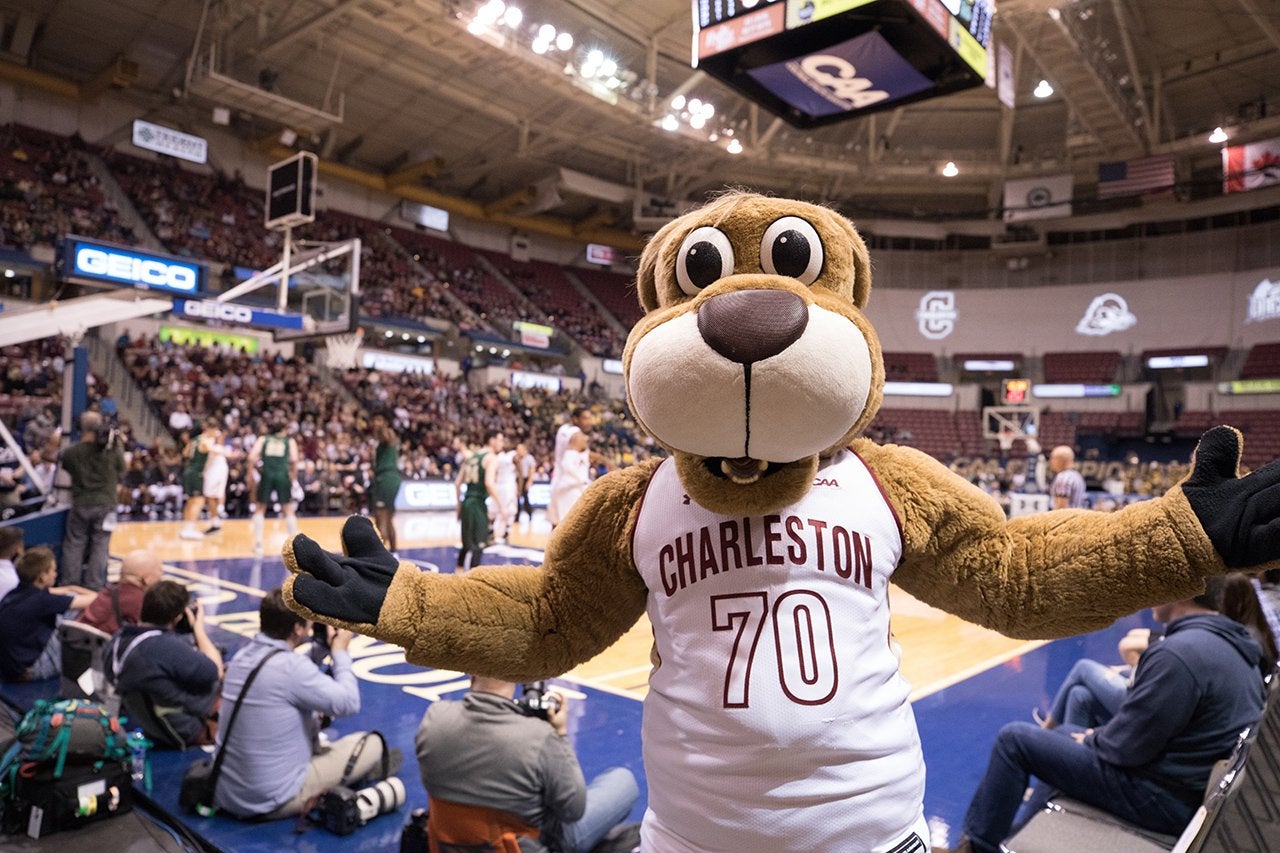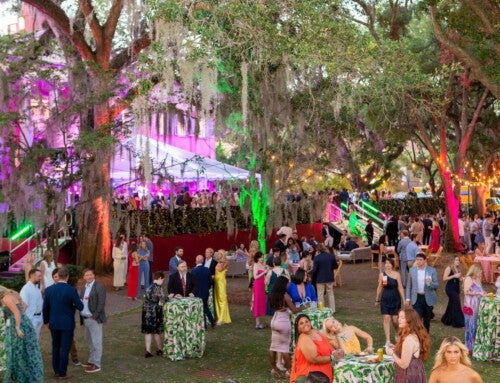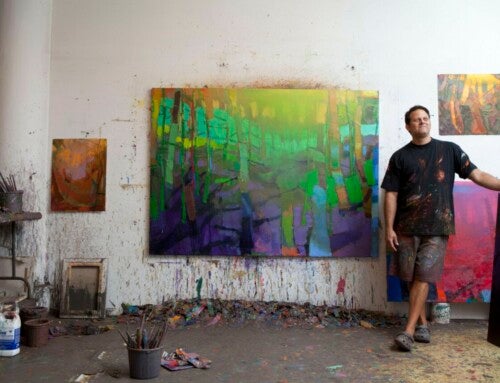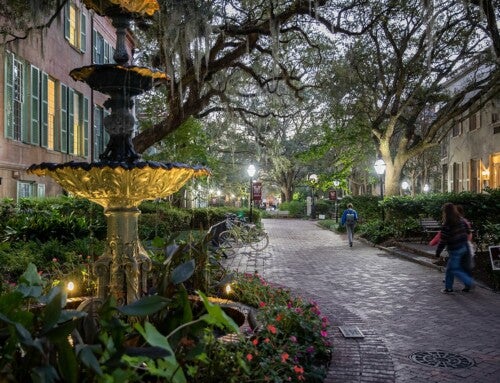Clyde the Cougar is ever-present – storming the basketball court with us after upset wins, lifting our spirits when our teams struggle, entertaining our littlest fans. From games to grand openings, photo ops to parades, our beloved mascot has been a mainstay at the College for more than three decades. But who is Clyde and how did he become the face of the College?
words by Ron Menchaca ’98
images by Mike Ledford
In the span of nearly two and a half centuries of College of Charleston history, he is but a blip on our institutional radar. But in the relatively short period of time he has served as the College’s official mascot, Clyde the Cougar has become to many a beloved and irreplaceable symbol of our university, as recognizable and symbolic as Randolph Hall or the Cistern Yard.
From humble beginnings in a shabby, ill-fitting and somewhat menacing-looking cougar suit in the 1970s to today’s wide-eyed, cartoonish version, Clyde has evolved with the times. The modern iteration of Clyde maintains a busy performance schedule, collects appearance fees and boasts his own Twitter handle.
No one person can lay claim to the title of Clyde. He is a composite of generations of student volunteers who have, quite literally, given their blood, sweat – lots of sweat – and tears to embody this goofy, lovable, strutting hunk of feline fun.
By the time Todd Crowe ’86 entered the College as a freshman in 1982, the cougar had been the official mascot for more than a decade. Prior to the 1970-71 school year, the College’s student-athletes competed as the Maroons.
A native of Simpsonville, S.C., Crowe had dreamed of becoming a doctor since he was old enough to know what a doctor was. Along the way to achieving that goal, Crowe – now a practicing anesthesiologist in Seneca, S.C. – almost single-handedly created the mascot we know today as Clyde the Cougar.
While the College did, in fact, have a Cougar mascot suit through the 1970s and early ’80s, there was no formal mascot program and no dedicated cadre of students volunteering to act the part of the nameless cougar.
“At that time, the suit was probably 10 years old,” says Crowe. “It was just something that they had around and someone would occasionally put it on.”
One night in 1982, Crowe was attending an early-season women’s basketball game in the newly opened Johnson Center. As was often the case, the cougar mascot was nowhere to be found. Instead, someone had mercifully displayed a stuffed toy cougar on a courtside chair.
Crowe shook his head in disbelief as he stared at the lifeless, uninspiring plush doll: “I saw that and I said, ‘Really? This is our mascot?’”
Determined to remedy this perceived affront to school spirit, Crowe tracked down a classmate who was known to occasionally wear the drab fleece suit for campus events.
Crowe made his pitch: “I really have an interest in taking this and developing it into a character, having some props and having a costume made for him and coming up with a name, let him really develop into something the College can be proud of and people can rally around.”
If Crowe was expecting resistance, he got none. “Knock yourself out,” the part-time cougar replied.
Following an informal polling of his friends and classmates, Crowe settled on a name for the mascot, and Clyde was born.
Soon, Crowe was wearing the costume everywhere he could. He commandeered some hand-me-down T-shirts and uniforms to clothe his new pal. Clyde became a regular at basketball games and campus events. He frequently roamed downtown, often stopping by the student hangout, the Cougar’s Den. He also made an appearance in the Charleston Christmas parade that year.
Crowe’s timing could not have been better. He brought enthusiasm, organization and professionalism to the role of Clyde at the precise moment the men’s basketball team, under Head Coach John Kresse, was gaining national attention.
Mascots are an integral part of athletics at every level, Kresse says, and with the addition of Clyde, the Cougars became a complete team: “I truly believe, especially in college, the mascot, the cheerleaders, the dance team and the bands make the pageantry of college sports the best there is.”
The Cougars’ run toward a national championship in 1983 also provided Crowe with an opportunity to upgrade Clyde’s costume. By then, the fragile, aging ensemble was fraying and reeked to high heaven. Under the guise of ensuring safe transport of Clyde’s head to the national tournament in Kansas City, Crowe convinced Women’s Athletics Director Joan Cronan to tote the smelly helmet on the airplane as her carry-on, confident that she would quickly recognize the urgent need for a new costume.
“She promised me once we arrived in Kansas City that I would be getting a new Clyde uniform for my sophomore year,” Crowe says, still chuckling about the ploy all these years later.
And, of course, the team went on to claim the national championship after winning five games in five consecutive days. The Cougars had clawed their way to the top, and their new mascot was with them through it all.
“Our championship run really took Clyde to the next level,” says Crowe.
 Being Clyde
Being Clyde
Crowe would serve as Clyde for four years before graduating – in full Clyde costume – in 1986. He took care to leave his alter ego in good hands, establishing a partial scholarship to help support future Clydes.
After a series of auditions before a panel of judges, Keith Reynolds ’87, a protégé of Crowe, was selected to be the next Clyde. And so began a tradition of outgoing Clydes handing over the reins to eager young cubs.
“I have very fond memories from my years as Clyde,” says Reynolds, an operations manager with Waste Management in Houston, Texas. “I was then, and I am still, very proud to be part of that legacy.”
In those early days, one student could handle the mascot duties. But nowadays, as many as four students share the job, with the more senior ones getting plum assignments like basketball games. With each successive generation of mascots, Clyde’s personality and mannerisms are refined and passed down.
Christian Smith ’13, who served as Clyde for two years and has also performed as the Charleston Riverdogs’ mascot Charlie, says it’s essential for mascot programs with multiple members to maintain the consistency of their mascot’s character.
“There is a specific Clyde walk that everybody has to be able to do,” says Smith. “There’s a certain thing you have to be able to do with signatures. There are things that every mascot, no matter who’s in the costume, has to do exactly the same every time because that’s what people see. After that, you can add your own little flair to it.”
The opportunity to infuse one’s own personality and strengths into the role of Clyde is part of what makes the job so much fun. Some Clydes are particularly athletic, some are great dancers and some are clever pranksters. For longtime Cougars fans, the individuality and uniqueness that each student brings to the role are often evident from year to year.
That diversity of Clydes over the decades has produced many unforgettable performances and classic moments. He’s cut a rug with actor Bill Murray, launched from a trampoline to throw down Air Jordan–style dunks, crowd surfed, amazed with magic tricks and proposed to a TV reporter in the middle of a live shot. Clyde has even been bar mitzvahed.
Many mascots have developed a persona for their Clyde in the same way that an actor channels a character for a performance.
Whenever Kristin Campbell Tarcza ’07 needed to tap the essence of Clyde’s signature swagger during the four years she served as the mascot, she conjured a specific archetype. “I always like to think of Clyde as a College of Charleston fraternity guy,” says Tarcza, now a counselor at a private school in New Orleans. “He’s a lot of fun, he’s laid back. He’s there to have a good time, but he’s very confident.”
To Smith, “Clyde is kind of that ornery middle schooler who likes to flirt and likes to hit on people and is very smooth-talking. One of my favorite things to do as Clyde was to propose to people and make it really uncomfortable for them.”
Malodorous Mascot
Spend some time watching Clyde and the College’s cheer and dance squads and you realize that these students are every bit as well conditioned and trained as the players on the court.
Not everyone who tries out has what it takes to be Clyde. It’s a different realm inside that head: your vision narrows, your depth perception becomes fuzzy and the sounds of the outside world blend into a muffled mess. Even the simple act of walking is a struggle when you’re sporting Clyde’s big, floppy clown shoes.
But most mascots will tell you that the most challenging aspect of being Clyde is the relentless heat generated inside the suit. Prancing around in the humidity of Charleston becomes unbearable after only a few minutes in costume. Only the strong can survive an entire game.
It used to be even worse. When Crowe was getting started as Clyde in the early ’80s, the College staged men’s and women’s basketball games back to back. Crowe might be in costume for five hours or more. To make things worse, this was during the era of Kresse, who liked to jack up the temperature in the gym to 85 degrees on game nights to gain a competitive advantage.
Part of what makes being a mascot so physically demanding is that a mascot must perform for the whole crowd, whether they are sitting courtside or up in the nosebleed section. Subtlety doesn’t translate in mascotting, says former Clyde mascot Sheryl Dizon ’13.
“When you are in the suit, you want to make sure that all the fans that come out have the same experience, whether they are right there in front of you or at the very top of the arena,” says Dizon. “You have to make sure your gestures and your movements are grand and big enough that they notice you.”
Naturally, all of that physical exertion leads to some serious perspiring. If you’ve ever been knocked back by the powerful odor of a locker room in the summer, you have some idea of how the Clyde suit begins to smell after several spirited uses.
It’s not like you can toss the expensive costume in the wash and soak away hours of sweaty antics, lung-busting gyrations and body-aching cartwheels. Caring for the costume is a delicate process, and taking it to the dry-cleaner only helps so much.
Despite everyone’s best efforts to keep the costume clean, Reynolds remembers that the thick fur constantly oozed rankness. “I heard more than once, ‘Mommy, Clyde smells funny.’”
But the physical exhaustion, the olfactory challenges, the imperative to stay in shape – these are small sacrifices compared to the rewards of being the center of attention, the life of the party and, most importantly, a source of wonder and happiness for children.
 For the Kids
For the Kids
The fist-bumping fraternity brother knows that Clyde could be his classmate peering back at him from behind the whiskered snout. The unsuspecting lady who gets a dance twirl from Clyde knows that Clyde is playing a role and she’s part of the act.
But the kids in the crowd, they don’t always know that it’s make-believe. Before they understand the rules of the game, care which player is having a breakout season or can comprehend the significance of the big red numbers on the scoreboard, most children are drawn to mascots like Clyde. These live-action cartoon characters are a special part of the sports world, and when you get right down to it, the primary role of the mascot is to entertain the youngest fans in the crowd.
“The most important element of the audience at games is the children,” says Kresse. “A mascot can be a big hit and something that propels a youngster to love a team, a sport, and keep coming back to the games for a long time.”
Most mascots will tell you that, of all the crazy and unpredictable experiences they’ve had in costume, the most treasured ones are the interactions with children.
“I loved working with kids, so they were always the fans I would gravitate toward,” says Dizon, who works as an aide for special needs children in the Sumter (S.C.) School District. “There are kids that would yell ‘Clyde,’ and run up and hug you. But then there are ones who would shy away and run and hide behind their parents.”
Because Clyde can seem so very real to a child, Smith often debated whether to perform certain moves on the court. “The head never really stayed on, so it was always a panic when you did a front flip or somersault whether that head was going to pop off and scare some little kid.”
But, other times, it’s the fans who scare the mascot.
“Knob Clob”
Being a mascot is a relatively safe gig when your team is playing at home. But things can get dicey when you go on the road to play a rival. Even confident Clyde gets nervous when the Cougars are playing at The Citadel, especially, if as Crowe once did, Clyde boldly struts into The Citadel’s McAlister Field House wearing a T-shirt that says “Knob Clob” and a cadet cap on his head.
Perhaps not surprisingly, a mob of cadets pounced on Clyde, determined to teach him some respect and get their cap back. They not only stripped Clyde of his prized hat but also managed to rip off his cougar tail before Crowe could slip away.
Games at the military college were always an intimidating experience for Clyde, says Reynolds. “I always had a police escort follow me around during the game.”
Tarcza, however, preferred to move about without a guide. But she rethought that strategy after a game at The Citadel in which she found herself surrounded by a company of rowdy, testosterone-fueled cadets.
“They got a little rough,” she recalls. “They assumed I was a guy.”
The Rules of Fun
Mascots have a professional code. And among the most sacred of these rules is that a mascot never reveals his or her identity.
In fact, mascots speak in hushed tones about violations of this cardinal order in the same way that professional athletes gossip about competitors suspected of using performance-enhancing drugs.
“You were not supposed to tell people you were Clyde,” says Smith. “We’d get together and go to these conferences, and we’d talk about stuff like that. If you ever were exposed, we’d all know about it and kind of almost shun you.”
But after a few years, it could become difficult for even the most disciplined Clydes to maintain the farce among their closest friends. One of Dizon’s friends who played on the women’s basketball team was upset that Dizon never came to see her play in games. “I’m at your games,” Dizon assured her. “I’m literally your No. 1 fan.”
But to preserve the friendship, she eventually confided that she was Clyde.
Tarcza spilled the beans to her then-boyfriend and now-husband, Walter Tarcza ’06, so he would understand why she was going to basketball games without him.
Another rule is that mascots are always on duty. After Dizon became separated from the rest of the cheer and dance team while participating in the Charleston Christmas parade one year, she wandered over to Marion Square and sat down on a bench to wait for an escort. She had almost forgotten she was still in costume when strangers started cozying up to her.
“People thought it was a photo op, like when you come and see Santa,” she says.
Kresse had his own special rule that applied to mascots. The coach had a standing order with the team that he was the only one allowed to get a technical foul in a game. Unaware of this commandment, Crowe was performing as Clyde in a game one night when he got caught up in the excitement and decided to imitate an unsuspecting referee.
While the crowd was amused, the referee slapped the team with a tech. Kresse was livid: “I remember that I was mad at Clyde for at least a week or so until we won our next game.”
 Forever Young
Forever Young
Mascots remain frozen in time. Their permanent smiles never slacken, their energy never wanes.
When it’s time for a crop of Clydes to say goodbye to the College, a new class of Cougars steps on to the court. The cycle ensures that Clyde is always fresh, always in top form.
But for those who have worn the costume, life moves on. The stamina that once enabled them to perform for hours at a time eventually declines. The athleticism and fearlessness that made them great mascots give way to creaky joints and restraint.
Sure, being Clyde is a silly job. But in a sports world that can sometimes take itself too seriously, mascots matter. And you’d be hard pressed to find a former or current Clyde who carries anything but pride and cherished memories of their time in the suit.
Walk through Tarcza’s house, and you’ll find framed photos of her days as Clyde.
Reynolds spoke so fondly of his run as Clyde that he inspired his daughter, Melaina Castengera, to enroll at the College.
Whenever Dizon is asked to give a fun fact about herself, she knows just the one to share.
Smith still dreams of becoming a mascot for a professional sports team. For now, he’s content as the director of theater and an adjunct faculty member at a private school in Sumter, S.C. Recently, he’s been working with his students to establish a mascot program for the school.
You never outlive your days as a mascot. It’s forever a part of you. And when you least expect it, that exhilarating chapter of your college life comes roaring back.
Years after Crowe had left the College and was getting his medical career started, he struck up a conversation with a couple inside a Greenville, S.C., restaurant. As it turned out, the woman had once dated a guy from The Citadel, and she told the story of how her boyfriend had stolen the tail of the College’s mascot and given the war trophy to her as a gift. She bragged that she still had it, having no idea she was talking to the first Clyde, that Clyde.
Shocked, Crowe looked sternly at the woman and said, “I want my tail back.”




